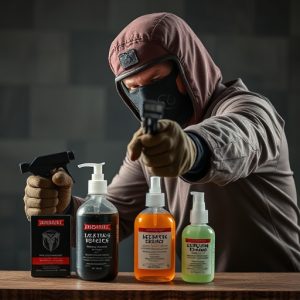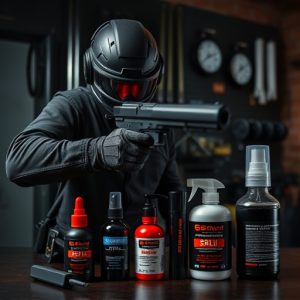Modern Safety Essentials: Mastering Self-Defense and Security Product Strategies
Self-defense and security products have significantly advanced, offering a range of solutions from t…….
Self-defense and security products have significantly advanced, offering a range of solutions from traditional items like pepper spray and stun guns to sophisticated devices such as personal alarms and wearable cameras. These tools are integral for immediate response and deterrence against threats, emphasizing individual empowerment in safety plans. The sector's evolution includes the rise of smart security systems capable of remote surveillance, instant alerts, and automated threat responses, indicating a commitment to innovation. Keychain pepper sprays, stun guns, Tasers, personal alarms, and self-defense training are all components of a comprehensive safety strategy that must be tailored to individual needs and legal requirements. The transformation in security product technology from basic locks to modern smart systems has revolutionized both property and personal protection, with advanced features like biometric locks, facial recognition, AI analytics, and real-time surveillance. In the digital realm, organizations must evaluate a wide array of cybersecurity solutions, including firewalls, intrusion detection systems, and endpoint protection software, to build a robust defense infrastructure against increasingly sophisticated cyber threats. A multi-layered approach that combines these technologies with ongoing employee training and policy adherence is essential for effective cybersecurity. Investing in self-defense and security products, both physical and digital, is a strategic necessity for safeguarding assets, personnel, and organizational integrity in today's complex threat landscape.
In an era where safety concerns permeate every facet of life, from personal well-being to protecting assets, the importance of self-defense and security products cannot be overstated. This article delves into the critical role these tools play in modern safety protocols, exploring a spectrum of options that range from traditional locks to sophisticated surveillance systems. We will navigate the evolution of security products, shedding light on how they have transformed our ability to safeguard what matters most. Further, we will scrutinize the efficacy of these tools, providing insights into their performance in protecting personal safety and assets. Join us as we unravel the significance of self-defense and security products in today’s landscape.
Understanding the Role of Self-Defense and Security Products in Modern Safety Protocols
In the context of modern safety protocols, self-defense and security products play a pivotal role in safeguarding individuals and properties alike. The landscape of personal protection has evolved significantly, with an array of innovative devices designed to deter threats and provide immediate response capabilities. These tools range from traditional self-defense items like pepper spray and stun guns to more sophisticated systems incorporating advanced technologies such as personal alarms and wearable cameras that record incidents. The effectiveness of these products lies in their ability to serve as both a deterrent and a direct defense mechanism when confronted with danger. Users can rely on these tools to incapacitate an assailant, alert authorities discreetly, or document an event for legal recourse. As such, they are increasingly integrated into comprehensive personal safety plans, complementing broader security strategies in both residential and commercial settings.
The integration of self-defense and security products within modern safety protocols also underscores a shift towards proactive rather than reactive measures. The importance of empowering individuals with the means to protect themselves cannot be overstated, as these tools offer a first line of defense that can significantly reduce the risk of personal harm or property theft. Moreover, the advent of smart security products has further enhanced this landscape, with devices now capable of remote monitoring, real-time notifications, and automated responses to detected threats. These advancements underscore the ongoing evolution of self-defense and security measures, highlighting a commitment to continuous innovation in the field of personal protection.
Top Self-Defense Tools for Personal Protection: A Comprehensive Guide
In the realm of personal protection, understanding the tools that can enhance one’s self-defense capabilities is paramount. A well-rounded approach to self-defense incorporates a variety of security products tailored to different situations and individual needs. Keychain pepper sprays are among the most accessible and effective non-lethal self-defense tools, capable of deterring attackers by causing temporary inflammation and discomfort upon contact. They are compact, legal in many jurisdictions, and offer a quick response option for potential threats at a safe distance. Stun guns and Tasers are also popular choices within the category of electronic self-defense devices. These security products deliver a high-voltage electrical charge that incapacitates an assailant, providing the user with a critical time advantage to escape. It’s important to familiarize oneself with the legal implications and proper usage of these tools, as they can vary by region. Personal alarms serve as a deterrent by emitting a loud sound designed to attract attention and alarm would-be attackers, while also signaling to nearby individuals that help is needed. Additionally, self-defense training, such as martial arts or defensive tactics courses, complements the use of physical tools by equipping individuals with the skills necessary to defend themselves effectively in a variety of scenarios. Always prioritize legal and ethical considerations when selecting and using self-defense tools, ensuring they align with local laws and regulations for personal protection.
The Evolution of Security Products: From Basic Locks to Advanced Surveillance Systems
Over the years, the landscape of security products has transformed dramatically from rudimentary locks to sophisticated surveillance systems. The journey began with simple mechanisms like bolts and bars, which were early human innovations for protection against intruders. These basic locks, a fundamental self-defense measure, provided a sense of safety to property owners. As time progressed, advancements in technology led to the development of more complex security systems. These included electronic locking devices, motion-detecting alarms, and CCTV cameras, which significantly enhanced the capabilities to monitor and protect both residential and commercial premises.
Today, the evolution of self-defense and security products continues at a rapid pace. With the advent of smart technology, we now have home automation systems that integrate with security solutions. These smart systems offer real-time monitoring, remote access control, and advanced surveillance capabilities, often connected to central monitoring stations for immediate response. Biometric locks, facial recognition software, and AI-driven analytics are becoming commonplace, providing unprecedented levels of protection. The integration of these technologies not only deters potential threats but also allows for swift action when a security breach is detected, signifying a new era in the field of self-defense and security products.
Evaluating the Efficacy of Self-Defense and Security Tools in Protecting Your Assets and Personnel
In an era where cyber threats loom large, evaluating the efficacy of self-defense and security tools is paramount for safeguarding assets and personnel. Organizations must assess a variety of security products designed to shield against malicious activities. These tools range from firewalls and intrusion detection systems to advanced endpoint protection software. Each plays a crucial role in creating a robust defense mechanism, thwarting unauthorized access, and deterring cybercriminals from exploiting vulnerabilities within networks or systems. The effectiveness of these security products is not solely determined by their ability to detect and prevent threats but also by their capacity to respond swiftly and intelligently when an intrusion is detected. Real-time monitoring and automated response capabilities are essential features that can significantly reduce the window of opportunity for attackers, thereby minimizing potential damage.
Moreover, the integration of these security tools into a comprehensive strategy that includes employee training and policy enforcement further enhances protection. Personnel must be well-versed in recognizing potential threats, practicing good cyber hygiene, and understanding their role in maintaining the organization’s security posture. By combining cutting-edge technology with informed human vigilance, organizations can create a multi-layered defense that is more resilient against a wide array of cyber threats. In this context, investing in self-defense and security products is not just a cost center but a strategic move to ensure the longevity and integrity of both digital and human assets within an organization.


